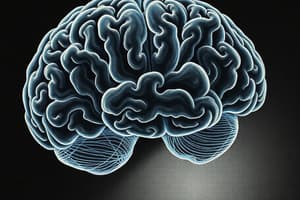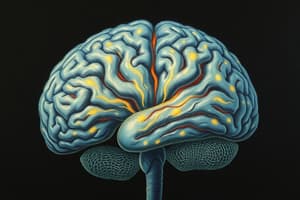Podcast
Questions and Answers
What is the primary function of the brain stem?
What is the primary function of the brain stem?
- Regulate sleep patterns and circadian rhythm
- Connect the brain to the spinal cord and manage internal organ functions (correct)
- Process sensory information exclusively
- Control voluntary muscle movements
Which part of the brain is primarily responsible for balance and coordination?
Which part of the brain is primarily responsible for balance and coordination?
- Thalamus
- Hypothalamus
- Cerebrum
- Cerebellum (correct)
What is the primary function of the hypothalamus within the diencephalon?
What is the primary function of the hypothalamus within the diencephalon?
- To interpret visual input
- To control voluntary muscle movement
- To process auditory information
- To maintain homeostasis (correct)
What role does the hypothalamus play in the brain's functionality?
What role does the hypothalamus play in the brain's functionality?
Which lobe of the brain is primarily responsible for voluntary muscle control and problem solving?
Which lobe of the brain is primarily responsible for voluntary muscle control and problem solving?
Which structure in the brain acts as a relay station for sensory information?
Which structure in the brain acts as a relay station for sensory information?
Which of the following is true regarding the midbrain?
Which of the following is true regarding the midbrain?
Which structure in the brain is often referred to as the 'gatekeeper of the cerebrum'?
Which structure in the brain is often referred to as the 'gatekeeper of the cerebrum'?
What is the role of the ventricles in the brain?
What is the role of the ventricles in the brain?
What is the main purpose of spinal reflexes?
What is the main purpose of spinal reflexes?
Which component of the spinal cord contains long fibers that transmit nerve impulses?
Which component of the spinal cord contains long fibers that transmit nerve impulses?
Which area of the brain is most developed and responsible for higher mental capabilities?
Which area of the brain is most developed and responsible for higher mental capabilities?
What action takes place during the knee-jerk reflex?
What action takes place during the knee-jerk reflex?
The central sulcus separates which two lobes of the brain?
The central sulcus separates which two lobes of the brain?
Which of the following best describes the structure of the vertebrate brain?
Which of the following best describes the structure of the vertebrate brain?
What is the primary function of the cerebellum?
What is the primary function of the cerebellum?
Which lobe is primarily involved in interpreting visual input?
Which lobe is primarily involved in interpreting visual input?
What is the primary role of cranial nerves in the peripheral nervous system?
What is the primary role of cranial nerves in the peripheral nervous system?
Flashcards
Central Nervous System
Central Nervous System
The control center of the body, made up of the brain and spinal cord. It receives information, processes it, and sends out commands to other parts of the body.
Cerebrum
Cerebrum
The largest part of the brain responsible for higher mental functions like thinking, problem-solving, and voluntary movements.
Frontal Lobe
Frontal Lobe
The front part of the cerebrum responsible for voluntary muscle control, thinking, problem-solving, speech, and smell.
Parietal Lobe
Parietal Lobe
Signup and view all the flashcards
Occipital Lobe
Occipital Lobe
Signup and view all the flashcards
Temporal Lobe
Temporal Lobe
Signup and view all the flashcards
Diencephalon
Diencephalon
Signup and view all the flashcards
Hypothalamus
Hypothalamus
Signup and view all the flashcards
Brain Stem
Brain Stem
Signup and view all the flashcards
Thalamus
Thalamus
Signup and view all the flashcards
Midbrain
Midbrain
Signup and view all the flashcards
Pons
Pons
Signup and view all the flashcards
Medulla Oblongata
Medulla Oblongata
Signup and view all the flashcards
Spinal Cord
Spinal Cord
Signup and view all the flashcards
Sensory Neuron
Sensory Neuron
Signup and view all the flashcards
Study Notes
Central Nervous System (CNS)
- CNS comprises the brain and spinal cord, containing all neuron components.
- The brain houses centers directing nervous system regions.
- Sheep brains are commonly used for study due to their accessibility and large discernible parts.
- Ventricles are interconnected spaces containing cerebrospinal fluid (CSF), cushioning the brain.
Brain Structures
-
Cerebrum: Largest, most developed brain region; responsible for higher functions.
- Divided into left and right hemispheres connected by the corpus callosum, a sheet of white matter.
- Divided into lobes:
- Frontal Lobe: Controls motor functions, voluntary movement, cognition, problem-solving, speech, and smell.
- Parietal Lobe: Receives sensory input from skin and taste receptors (gustatory cortex). Separated from the frontal lobe by the central sulcus.
- Occipital Lobe: Processes visual input, integrating with other sensory data. Optic nerves split at the optic chiasma (in the diencephalon) to reach opposite brain sides.
- Temporal Lobe: Houses sensory areas for hearing and smell, including the olfactory bulb (olfactory cortex). Olfactory bulb receives nerve impulses from olfactory cells in the nose.
-
Diencephalon: Region housing the third ventricle and crucial structures:
- Thalamus: Two connected lobes, highest brain area receiving sensory impulses; "gatekeeper," controlling sensory data to the cerebrum.
- Hypothalamus: Forms third ventricle floor; controls homeostasis (appetite, body temperature, blood pressure, water balance), as well as pressure, reproductive behavior, hostility, and pain.
-
Cerebellum: Coordinates balance, equilibrium, and smooth motor activity.
-
Brainstem: Connects brain and spinal cord; includes pons and medulla oblongata. Controls vital functions (e.g., internal organ functions, breathing, heart rate, blood pressure) and serves as a relay station for nerve impulses. Subdivisions:
- Midbrain: Sensory and motor relay station, eye muscle reflex center, hearing, and motor coordination.
- Pons: Pathway for nerve impulses between medulla and the higher brain.
- Medulla Oblongata: Controls vital functions such as heart rate, blood pressure, and breathing, and serves as a relay station for nerve impulses between the spinal cord and higher brain centers; also involved in swallowing, digestion, and vomiting.
Human Brain
-
Cerebrum: Largest portion; controls thinking, memory, emotion, decision-making, sensation, movement, and coordination of voluntary actions. Divided into two symmetrical hemispheres.
-
Cerebellum: Aids in balance, coordination, and fine motor skills.
-
Diencephalon: Includes:
- Thalamus: Relays sensory information, processes sensory signals (touch, sight, sound, taste) and sends it to the cerebrum for processing; crucial in alertness and sleep regulation.
- Hypothalamus: Maintains homeostasis (hunger, thirst, body temperature, circadian rhythms); controls endocrine system and affects stress and growth.
-
Brainstem: Includes:
- Midbrain: Communication center and controls eye movement, processing hearing and motor control.
- Pons: Regulates breathing and supports smooth coordination and balance.
- Medulla: Controls vital functions (heart rate, blood pressure, breathing), swallowing, and digestion.
Vertebrate Brain Comparison
- Vertebrate brains feature a forebrain, midbrain, and hindbrain.
- Early vertebrates showed specialization: forebrain (smell), midbrain (sight), hindbrain (hearing/balance).
- Forebrain: Contains olfactory bulb and cerebrum.
- Midbrain: Contains optic lobe.
- Hindbrain: Contains cerebellum.
- In fishes and amphibians, the midbrain is a dominant center for control, while fish, bird, and mammal cerebrums are well-developed and increase in complexity.
Spinal Cord
- Located in the mid-dorsal region, protected by the vertebral column.
- Grey Matter: Butterfly-shaped core of short nerve fibers, interneurons, and motor neuron cell bodies.
- White Matter: Contains long nerve fibers (with insulating myelin sheaths) carrying impulses up and down the cord.
Peripheral Nervous System (PNS)
- Includes 12 pairs of cranial nerves and 31 pairs of spinal nerves.
- Cranial nerves facilitate communication between the head, neck, and face and the brain.
Spinal Nerves
- Each nerve contains sensory and motor neuron fibers.
- Sensory Neuron: Carries impulses from sensory receptors to spinal cord; cell body in dorsal root ganglion.
- Interneuron: Located in the spinal cord; relays information between sensory and motor neurons, some also relaying information to and from the brain.
- Motor Neuron: Carries impulses from the spinal cord to effectors (muscles), causing contraction in response to stimuli.
Spinal Reflexes
- Reflexes are involuntary, predictable responses to stimuli, enabling rapid reactions.
- Sequence of a spinal reflex: Receptor detects stimulus → sensory neurons conduct impulse to spinal cord interneurons → interneurons relay impulse via motor neurons to effectors (muscles.)
- Example (knee-jerk reflex): Tapping patellar tendon stretches muscle, stimulating receptor → sensory input, spinal cord, motor output → muscle contraction.
Experimental Procedure (Knee-Jerk Reflex)
- Tapping the patellar tendon stretches the attached muscle, generating nerve impulses → sensory neurons → spinal cord → motor neurons → muscle contraction. These reflexes help maintain balance and posture.
Studying That Suits You
Use AI to generate personalized quizzes and flashcards to suit your learning preferences.




